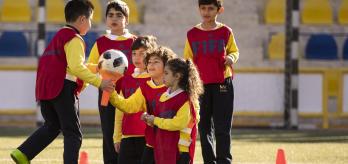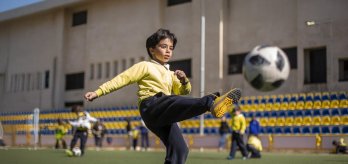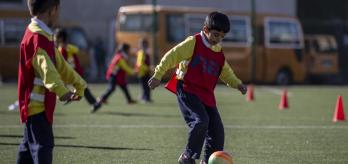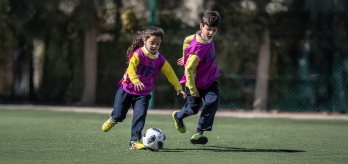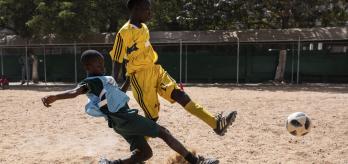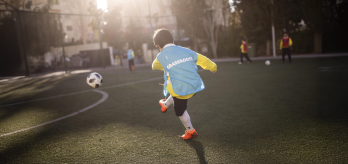A child cannot learn to shoot, pass or dribble properly without first being able to control the ball. For players at grassroots level, mastering their relationship with the ball not only boosts their enjoyment of the game but also equips them with the tools they need to grow as creative, skilful footballers.
In this edition of FIFA’s Grassroots Coaching Essentials series, Dr Jené Baclawski is back on our screens once more as she aims to explain how coaches, working with players between the ages of 4 and 8, can create effective sessions that will help develop better ball control. She emphasises three key tips to do so: build confidence through touches, structure progressive sessions, and encourage plenty of repetition.
Below, you will find a presentation in which Jené expands on her tips and shares practical strategies for helping children develop their ball mastery through engaging, game-like situations. The video is followed by a written summary and three age-appropriate activities to support players as they gain control, composure and, eventually, confidence with the ball at their feet.
Tip 1: Begin with ball control basics
Helping players to master ball control begins with simple, fun activities that encourage freedom to build confidence on the ball. In this section, Jené outlines three ways that coaches can support children in growing their composure on the ball by beginning with the basics:
-
Build confidence with the ball: Coaches should design practices so that the ball is always in play, allowing every player to have as many touches as possible. The more time on the ball they have, the more their confidence grows.
-
Try something new: Always give players the license to experiment with new techniques. Mistakes are a part of learning and lead to better decision-making and ball mastery.
-
Reinforce scanning: Train the habit of scanning the pitch before and after controlling the ball, making the exercise mirror real-match demands.
Tip 2: Plan progressive sessions
As players become more comfortable with controlling the ball, it is vital to structure sessions to build on the last one and provide plenty of repetition. To maximise this development, Jené believes that coaches should focus on three key elements when designing practice:
-
Incorporate other skills: Once the fundamentals of ball control have been established, coaches should start layering other key elements of the game into the session, such as passing and receiving.
-
Work as a team: Passing to a team-mate requires accuracy and care, meaning players will be much more attentive to their first touch, the weight of the pass and their decision-making.
-
Implement game-like scenarios: By implementing game-like situations into activities, players can practise their ball control under pressure, whether dribbling past an opponent, linking up with a team-mate or having a strike at goal.
Tip 3: Focus on practice and repetition
Regular practice is essential for young players to turn ball control into second nature. Through encouraging repetition, positive guidance from the sidelines and playing in the right environment, coaches can help children develop lasting habits and greater confidence on the ball. Here, Jené explains the most important factors:
-
Muscle memory: Having repetition in activities helps young players to develop instinctive movements and improves their understanding of how to apply them in-game.
-
Coaching feedback: Coaches should always encourage players to be alert, keeping their heads up, moving on their toes and being ready to offer support before the ball arrives to them to control.
-
Positive environment: A fun, positive environment allows children to take risks, learn from mistakes and improve their ball control. When players feel supported and enjoy themselves, they are more likely to stay engaged and to keep practising and developing their technique over time.
Key Take-aways
By designing sessions that are simple, progressive and engaging, grassroots coaches can provide young players with the best chance to grow in confidence and ability on the ball. Here is a summary of the key take-aways from Jené’s presentation on helping children master ball control:
-
Practice makes perfect: Repetition is key for children of all ages to develop their ball control skills, and coaches should design practices that allow for as many touches on the ball as possible.
-
Play in realistic situations: Real-game scenarios help keep players engaged and enable them to have fun while developing core football skills.
-
Design a progressive session: Each activity should build on the last, progressively introducing new elements to the session to help players develop their ball control skills.


